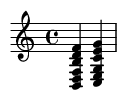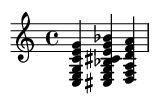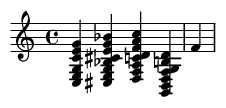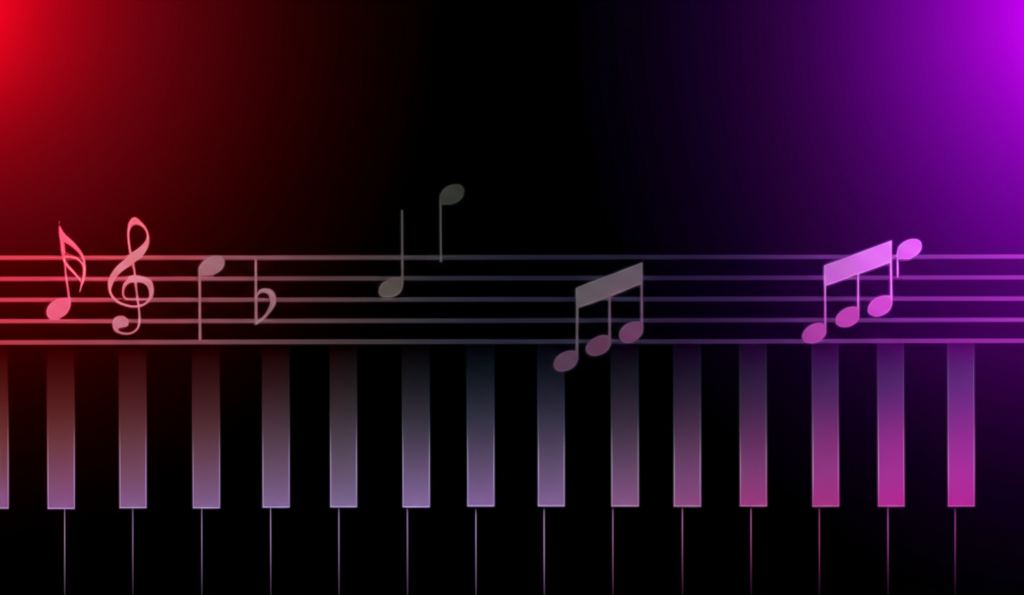Diminished Chord: A Guide to Music's Most Mysterious Harmony
Summary:
The diminished chord, a unique harmony built from a stack of minor thirds, is one of the most tension-filled and unstable sounds in Western music. This guide explores its structure, types, and crucial functions—from creating suspense in film scores to facilitating sophisticated modulations in classical and jazz music.
Keywords:
Diminished chord, diminished seventh, half-diminished chord, music theory, unstable harmony, leading tone, tension and resolution, passing chord, substitute dominant, jazz harmony, film music, symmetrical chord.
Introduction: What is the Diminished Chord?
If musical chords were characters in a story, the major chord would be the hero and the minor chord the melancholic poet. The diminished chord? It would be the mysterious stranger, the double agent, the harbinger of suspense. Built entirely from minor third intervals, this chord creates a uniquely tense and unsettled sound that begs for resolution.
Its inherent instability and ambiguous nature make it an incredibly powerful tool for composers and improvisers. From the dramatic flourishes of classical music to the sophisticated turnarounds of jazz and the nail-biting tension of a film score, the diminished chord is a master of harmonic drama and transition.
Structure and Construction: Stacking Minor Thirds
The signature sound of a diminished chord comes from its unique construction: it is a stack of minor thirds (an interval of 3 semitones). This symmetrical pattern is key to its sound and function.
- Diminished Triad: Root, minor third, and a diminished fifth. The interval from the root to the fifth is a tritone, a famously dissonant interval.
- Diminished Seventh Chord: Root, minor third, diminished fifth, and a diminished seventh. This chord is perfectly symmetrical, as every adjacent note is a minor third apart.
C Diminished Chord Examples:
C Diminished Triad (Cdim): C - Eb - Gb
C Diminished Seventh (Cdim7): C - Eb - Gb - Bbb
A Note on Spelling: Notice the B-double-flat (Bbb). While this note sounds the same as an A on the piano, it is spelled as Bbb to maintain the chord's theoretical structure of stacked minor thirds (C to Eb, Eb to Gb, and Gb to Bbb are all minor thirds).
C Diminished Triad (Cdim)
This is the basic three-note diminished chord.

C Diminished Seventh Chord (Cdim7)
The four-note, fully symmetrical version.

The Diminished Family: Three Key Types
1. Diminished Triad (dim or °)
The foundational three-note chord (Root - b3 - b5). It appears naturally on the seventh degree (leading tone) of any major scale. For example, in C major, the seventh degree is B, and the diatonic triad is B diminished (B-D-F).
2. Diminished Seventh Chord (dim7 or °7)
This is the "fully diminished" chord (Root - b3 - b5 - bb7). Its symmetrical structure makes it incredibly versatile for modulation and creating tension. This is the chord most people think of when they say "the diminished chord."
3. Half-Diminished Chord (m7b5 or ø7)
A close cousin, the half-diminished chord is almost identical but has a minor seventh instead of a diminished seventh (Root - b3 - b5 - b7). This small change makes it sound less jarring and more melancholic. It appears naturally on the seventh degree of the major scale (as a seventh chord) and is extremely common in jazz as the 'ii' chord in minor key ii-V-i progressions.
Primary Harmonic Functions
A diminished chord's job is rarely to sit still; its purpose is to create tension that leads somewhere else. Here are its most common functions:
1. The Leading-Tone Chord
Built on the 7th degree of the scale, the leading-tone diminished chord pulls powerfully back to the tonic (the 'I' chord). Each note has a strong tendency to resolve by a small step, creating smooth and satisfying voice leading. In C major, the Bdim chord (B-D-F) resolves beautifully to a C major chord (C-E-G).
Example: Bdim resolving to C Major

2. The Chromatic Passing Chord
Diminished chords are perfect for connecting two diatonic chords that are a whole step apart. By inserting a diminished chord on the chromatic step between them, you create a smooth, stepwise bass line and add harmonic interest. A classic example is moving from a I chord to a ii chord, such as C → C#dim7 → Dm7.
Example: C - C#dim - Dm Progression

3. The Substitute Dominant
In jazz and classical music, a diminished seventh chord can stand in for a dominant 7th chord. This works because a diminished seventh chord built a half-step above the root of the destination chord shares many notes with the V7(b9) chord, creating a similar pull. For example, a G#dim7 (G#-B-D-F) can substitute for an E7 chord to lead to A minor, adding a darker, more complex flavor to the resolution.
The Magic of Symmetry
The diminished seventh chord's construction of stacked minor thirds gives it a unique "symmetrical" property. Because the distance between each note is the same, any of its four notes can function as the root. This means:
- One Chord, Four Names: A Cdim7 chord (C-Eb-Gb-Bbb) contains the exact same pitches as an Ebdim7, Gbdim7, and Adim7 (enharmonically spelled A).
- Only Three Unique Chords: Because of this property, there are only three unique diminished seventh chords in all of music! All others are just inversions or different spellings of one of these three groups of notes.
- A Tool for Modulation: This ambiguity makes the diminished seventh chord a powerful pivot for changing keys. A single diminished chord can resolve convincingly to four different major and four different minor keys, making it a composer's secret weapon for smooth and surprising modulations.
Applications Across Genres
Classical Music
Composers from Bach to Wagner used diminished chords for dramatic effect. Bach used them to express turmoil and suffering, while Romantic composers like Chopin and Liszt exploited their tension to build powerful emotional climaxes.
Jazz
Jazz harmony is rich with diminished chords. They are essential to the language, used as passing chords in ii-V-I progressions, as substitutes for dominant chords, and as the basis for improvisation using the "diminished scale."
Common Jazz Turnaround: I - #I°7 - iim7 - V7

Film and Media Music
The "scary movie chord" is almost always a diminished chord. Its unstable, unsettling quality is perfect for creating atmospheres of suspense, mystery, and horror. Listen for it in classic horror soundtracks or in any scene designed to make you feel on edge.
Famous Musical Examples:
Once you know what to listen for, you'll hear diminished chords everywhere:
- "Michelle" by The Beatles: The beautiful descending line in the verse ("Michelle, ma belle...") features a passing diminished chord.
- "Friend Like Me" from Disney's *Aladdin*: Features a classic, Vaudeville-style use of a climbing diminished chord for dramatic flair.
- The *James Bond* Theme: The final, tense chord of the iconic opening riff is a complex chord with a strong diminished character.
- George Gershwin's "I Got Rhythm": The "Rhythm Changes," a foundational jazz progression, often incorporates diminished chords as passing and substitute harmonies.
Common Mistakes and Tips
- Overuse: A little diminished goes a long way. Using it too often can sound clichéd or weaken its dramatic impact. Save it for moments that need that special tension.
- Forgetting to Resolve: The power of a diminished chord lies in its resolution. Leaving it hanging can be a specific effect, but generally, it needs to lead somewhere. Pay attention to smooth voice leading into the next chord.
- Incorrect Spelling: While C#dim7 and Dbdim7 sound the same, the correct spelling depends on the harmonic context and key signature. Spelling it correctly clarifies its function.
Conclusion: Embrace the Tension
The diminished chord is far more than just a "scary" sound. It is a sophisticated and versatile harmonic device that adds depth, color, and movement to music. Its unique combination of instability and symmetry gives it a chameleon-like ability to connect chords, change keys, and build emotional intensity.
By understanding how diminished chords are built and how they function, you unlock a new level of harmonic understanding. Whether you are composing, improvising, or simply listening, learning to appreciate the mysterious and unstable character of the diminished chord will enrich your musical experience immeasurably.
Historical Context and Musical Significance
Diminished chords emerged prominently during the Baroque era (1600–1750), where composers like J.S. Bach used them to heighten dramatic tension in sacred works and fugues. By the Romantic period, Chopin and Wagner exploited their dissonance for emotional extremes in pieces like the Prelude in C Minor and Tristan und Isolde. The chord's symmetrical structure—stacked minor thirds dividing the octave equally—grants it unique properties: it lacks a tonal "root," enabling abrupt modulations and chromatic voice-leading. This instability made it indispensable for signaling impending resolution, earning it the nickname "the harmonic question mark." In jazz, its role expanded as a substitute for dominant chords (e.g., G7 → Bdim7), facilitating complex progressions.
Progressive Exercises
Beginner
Build a diminished triad (root + minor third + diminished fifth) in all keys. Example: Cdim = C-E♭-G♭. Practice arpeggios hands separately at 60 BPM.
Intermediate
Resolve diminished seventh chords (e.g., Cdim7 = C-E♭-G♭-B𝄫) to tonic major chords. Example progression: Cdim7 → Cmaj. Apply in ii°-V-I sequences in minor keys (Dm7♭5-G7-Cm).
Advanced
Use diminished chords as passing harmonies in chromatic bass lines. Improvise over "Giant Steps" (Coltrane) substituting dominant chords with dim7 variants. Compose a 4-bar phrase using dim7 chords to modulate between distant keys (e.g., C to F♯).
Ear Training Tips
Recognize diminished chords by their tense, "clashing" quality. Practice:
- Interval Identification: Isolate minor thirds (C-E♭) and diminished fifths (C-G♭) within chords.
- Progression Drills: Listen for resolutions (e.g., dim7 → major chord in Disney ballads). Use apps like Tenuto for chord-quality quizzes.
- Song Examples: Study intros like The Beatles' "Michelle" (F#dim7) or jazz standards like "All the Things You Are" (Bdim7 in bar 5).
Common Usage in Different Genres
- Classical: Enharmonic modulation (Beethoven’s "Pathétique," mvt 1) or cadential tension (Bach’s BWV 543 Fugue).
- Jazz: Substitute for V7 chords (D♭dim7 for G7b9 in "Stella by Starlight").
- Pop/Rock: Add melancholy (Radiohead’s "Exit Music," Ebdim) or transition between sections (Michael Jackson’s "Thriller" pre-chorus).
- Film Music: Convey unease (Bernard Herrmann’s "Psycho" shower scene) or mystery (John Williams’ "Hedwig’s Theme").
